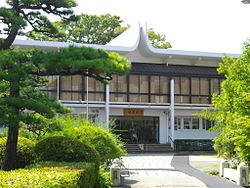
The Kokuchūkai (国柱会; "Pillar of the Nation Society") is a lay-oriented Nichiren Buddhist group. It was founded by Tanaka Chigaku in 1880 as Rengekai (蓮華会; "Lotus Blossom Society") and renamed Risshō Ankokukai (立正安国会) in 1884 before adopting its current name in 1914.
History
[edit]The lay Nichiren Buddhist organization[1] now known as the Kokuchūkai was founded by Tanaka Chigaku in 1880 as Rengekai ("Lotus Blossom Society") and renamed Risshō Ankokukai in 1884 before adopting its current name in 1914.[1][2] The group's modern name is derived from a passage in the Kaimoku-shō, a writing of the founder of Nichiren Buddhism, the 13th-century monk Nichiren, which reads "I will be the pillar of Japan" (われ日本の柱とならん, ware nihon no hashira to naran).[3]
Originally based in Yokohama, the group shifted its head office to Tokyo, Kyoto-Osaka, Kamakura and Miho, Shizuoka Prefecture before finally moving back to Tokyo.[1][4] The group is currently based in Ichinoe, Edogawa-ku.[1]
Teachings
[edit]Among the group's principal teachings are to return to the teachings Nichiren and unite the various sects of Nichiren Buddhism.[1] The group's teachings are characterized by a strong form of Nichirenism.[1]
The group's sacred text is the Lotus Sutra[1] and their main object of reverence is the Sado Shigen Myō Mandara (佐渡始原妙曼荼羅), a mandala supposedly made by Nichiren on the island of Sado.[1][5]
Membership
[edit]At its height in 1924, the group's membership was estimated at over 7000.[4] The literary figures Takayama Chogyū and Kenji Miyazawa[6] were members of the Kokuchūkai for a time. The group's official website continues to claim them,[7][8] but they ultimately rejected Tanaka's nationalistic views.[4]
Publications
[edit]The group's publications include the monthly magazines Nichiren-shugi (日蓮主義; "Nichirenism") and Shin-sekai (真世界; "True World").[1]
References
[edit]- ^ a b c d e f g h i Britannica Kokusai Dai-hyakkajiten article "Kokuchūkai". 2007. Britannica Japan Co.
- ^ Eiichi Ōtani, Ajia no Bukkyō-nashonarizumu no Hikaku-bunseki Archived 2018-04-20 at the Wayback Machine ("A Comparative Analysis of Buddhist Nationalism in Asia"). International Research Center for Japanese Studies. p. 115.
- ^ Nakahira 1994.
- ^ a b c Jacqueline I. Stone, "By Imperial Edict and Shogunal Decree: Politics and the Issue of the Ordination Platform in Modern Lay Nichiren Buddhism". In: Steven Heine; Charles S. Prebish (ed.) Buddhism in the Modern World. New York: Oxford University Press. 2003. ISBN 0195146972. pp. 197-198.
- ^ Risshō Ankoku no jitsugen e on the Kokuchūkai's official website.
- ^ Keene, Donald (1999), A History of Japanese Literature: Volume 4: Dawn to the West — Japanese Literature of the Modern Era (Poetry, Drama, Criticism), New York: Columbia University Press, p. 285, ISBN 978-0-2311-1439-4.
- ^ "Takayama Chogyū" on the Kokuchūkai's official website.
- ^ "Kenji Miyazawa" on the Kokuchūkai's official website.
Works cited
[edit]- Nakahira, Senzaburō (1994). "Kokuchūkai". Encyclopedia Nipponica (in Japanese). Shogakukan. Retrieved 2018-04-29.
External links
[edit]- Official website (Japanese)